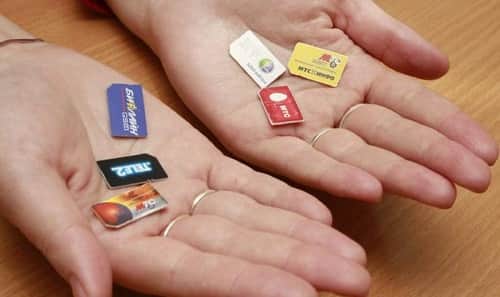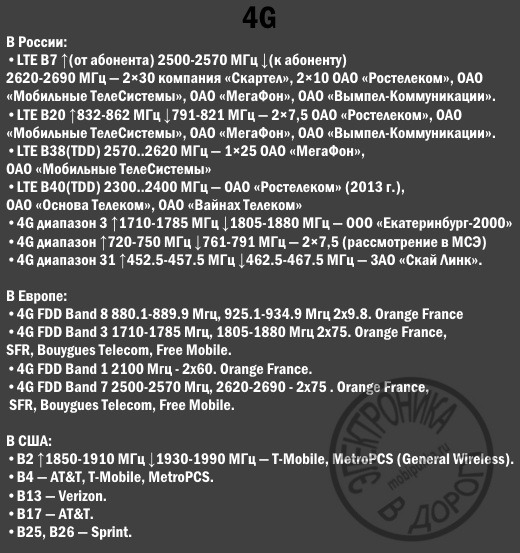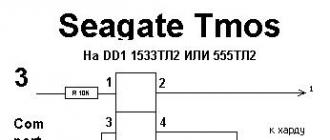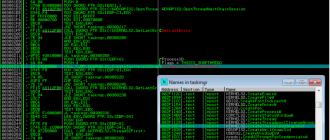The same frequency band is also used by television, Wi-Fi and Bluetooth. Among the range of frequencies there are those that have been allocated specifically for mobile phones.
Historically, the radio waves used for mobile communication systems in the countries of America, Europe, Africa and Asia differ from each other.
Technology and frequency standards
The first technology standard used in the US for commercial use was AMPS with a 800 MHz band. In the countries of northern Europe, NMT-450 technology was first introduced, the range of which was 450 MHz.
Together with the growing popularity of mobile phones, manufacturers faced a problem: they could not provide service to a large number of people. They had to develop existing systems and introduce a new standard with a different frequency range.
In Japan and some European countries, the TACS standard with a range of 900 MHz appeared. The GSM standard, which replaced the NMT-450 technology, also used the 900 MHz band. As demand grows and the cell phone market grows, providers have acquired licenses to use the 1800 MHz band.
Lower frequencies allow providers to cover larger areas, and higher frequencies allow communication to be provided to a larger number of clients in a smaller area.
Modern technology standards
The current generation of mobile devices operates mainly on the GSM standard. Also gaining popularity is the UMTS standard. In some countries, technologies of formats ELT, 3G, 4G are used.
Each standard or format uses a frequency band of two frequencies. The low frequency range transmits information from the mobile device to the station, and high - from the station to the mobile.
Many GPS phones cover three frequency bands: 900, 1800, 1900 MHz or 850, 1800, 1900 MHz. These are the so-called tri-band phones or tri-band devices. With such a phone it is convenient to travel the world, and it does not require replacement when
moving to another country.
Mobile networks different formats can use the same frequency. Such, for example, is the 800 MHz band used in at least four different formats.
Amount of frequencies available for use mobile deviceslimited This should be taken into account when the number of users increases. This means that a base station can provide a limited number of people, and the communication network needs to be constantly expanded.
Cell phones of the main providers in Russia operate at 900 MHz and 1800 MHz. At the same time, Megaphone, Beeline, MTS use both bands, and TELE 2 only 1800 MHz.
Modern life is filled with various technological devices. Daily people check email from their tablets and laptops communicate in social networks, call up with their friends and family from anywhere in the world. Although only sixty years ago, the latter could only be dreamed of. After all, what functions does the current smartphone, previously could only afford a computer the size of a small cabinet.
First cell phone
The first official cell phone was the apparatus of the American engineer Martin Cooper, director of mobile communications Motorola. On this device, on April 3, 1973, he first called his competitor from Bell Laboratories Corporation - Joe Engel.
The phone with the sticking antenna weighed a little more than one kilogram and worked in the talk mode for no more than an hour. The cellular device didn’t have any additional functions, just like the usual for a modern human display, only twelve keys (10 numeric, calling and ending a call).
According to the official version, the first commercial cell phone DynaTac was released on June 13, 1983 by Motorola.
However, there is every reason to say that the first cell phone was produced in the Soviet Union. It was a domestic radio engineer Leonid Kupriyanovich who created a sample mobile phone "LC-1", which was tested in 1957. The first "mobile phone" had a range of up to thirty kilometers, but its main disadvantage was an unacceptable weight for such a phone - three kilograms.
Therefore, a year later, Leonid Ivanovich improved the cell phone model. The updated device was the size of a pack of cigarettes and weighed only half a kilo. The phone allowed not only to make outgoing calls, but also to receive incoming calls from fixed phones and street machines.
The first official American mobile phone for sale cost almost four thousand dollars! For example, "Toyota King" of the same year was worth three hundred dollars cheaper. In this case, the owner of the phone had to monthly shell out another fifty dollars subscription fee.
The first mass-distributed cell phone was a Nokia 1011 device. He already had a small display and worked in the GSM standard. The first folding cell phone was the Motorola StarTAC.
Besides, mobile phone Motorola StarTAC was among the very first devices that had a screen with cells.
The first communicator was the Nokia 9000. It was made like a pencil case, on one side of it was a screen, and on the other a keyboard. This communicator was based on an Intel 386 processor.
A cell phone with an infrared port appeared in 2001 again under the Nokia brand. The first phone with mp3 player was the Samsung SPH-M100.
The receiver can be either a built-in device or a separate device that can be connected to a computer as a special card inserted into an expansion slot.
The same principle of operation is used by many electronic devices - cell phones, wireless networks, garage door drives, remote controls and so on. However, unlike infrared communication, on the basis of which these devices operate, radio frequency communication does not require that the mouse and receiver be located at an accessible distance from each other. The signal of the transmitter of the gadget easily passes through obstacles in the form of a computer monitor or table top.
Sync wireless mouse
As in most modern computer mice, wireless models use in their work not a ball, but an optical system, which significantly improves the accuracy of the gadget. In addition, the optical system allows the user to use a wireless mouse on almost all surfaces, which is very important for a device that is not connected to the computer with a cable for at least some time.
Another advantage of radio frequency communication is the minimum energy consumption of radio transmitters and receivers, which also weigh little, are inexpensive and can run on batteries.
Synchronization of a wireless mouse is necessary for the interaction of its transmitter with the receiver, which must operate on one channel, which is a combination of the identification code and frequency. Thanks to synchronization, interference from other wireless devices and unauthorized sources is prevented.
Each manufacturer equips its wireless mouse - some models (more expensive in the overall rating) are sold already synchronized, and some need to be automatically synchronized by pressing certain buttons on the device. The data transmitted by the mouse to the receiver is protected by encryption mechanisms or frequency hopping technology.
Sources:
- how the mouse works
Frequency FAQ cellular communication (GSM 900, DCS 1800, UMTS 2100, CDMA 450, 3G)
Uplink - communication channel from the subscriber (phone or modem) to the base station of the cellular operator. Downlink - communication channel from base station to the subscriber.
3G frequency:
Cellular communications of the 3rd generation in Russia operate at frequencies Uplink 1920–1980 MHz and Downlink 2110– 2170 MHz. Also operator Skylink has 3G frequencies in CDMA 450 standard: uplink 453-457.5 MHz and downlink 463-467.5 MHz.
GSM frequency:
GSM is the 2nd generation connection. GSM frequencies: uplink 890-915 MHz, downlink 935-960 MHz.
CDMA frequency:
On the CDMA 450, Skylink and W-CDMA (UMTS) are working with the Big Three operators. Slylink CDMA frequency - uplink 453-457.5 MHz and downlink 463-467.5 MHz. W-CDMA (UMTS) - Uplink 1920 - 1980 MHz and Downlink 2110 - 2170 MHz.

UMTS frequencies:
UMTS (Universal Mobile Telecommunications System) is a universal mobile telecommunication system. Actually, this is 3G. UMTS frequencies: Uplink 1920 - 1980 MHz and Downlink 2110 - 2170 MHz.
Frequency repeaters:
GSM frequency range:
GSM 900: uplink 890-915 MHz, downlink 935-960 MHz. There is an additional GSM frequency band, the so-called E-GSM - this is an additional 10 MHz. E-GSM: uplink 880-890 MHz, downlink 925-935 MHz.
GSM frequencies in Russia:
GSM 900: uplink 890-915 MHz, downlink 935-960 MHz. A total of 124 channels in GSM900. In each region of Russia, GSM frequencies are distributed between cellular operators individually.
Frequency 3G MTS:
Uplink 1950 - 1965 MHz and Downlink 2140 - 2155 MHz. MTS, like other cellular operators in the 3G band, is 15 MHz wide.
3G modem frequencies:
As a rule, all 3G modems operate at 3G / UMTS frequencies: Uplink 1920–1980 MHz and Downlink 2110– 2170 MHz., And support 2G network frequencies, that is, GSM900: uplink 890–915 MHz, downlink 935–960 MHz and DCS 1800 (aka GSM1800) Uplink 1710-1785 MHz and Downlink 1805-1880 MHz.
3G frequency range:
3G - in Russia it is CDMA450 (Skylink) and UMTS 2100. The frequency range of UMTS is Uplink 1920–1980 MHz and Downlink 2110– 2170 MHz, and CDMA450 is uplink 453-457.5 MHz and downlink 463-467.5 MHz
Skylink frequency:
The existing CDMA450 network is uplink 453-457.5 MHz and downlink 463-467.5 MHz. In September 2010, Skylink received a license for the frequencies 2100, namely 1920–1935 MHz and Downlink 2110– 2125 MHz.
GSM 1800 frequencies:
The GSM 1800 standard is more properly called the DCS1800. Its frequencies are Uplink 1710-1785 MHz and Downlink 1805-1880 MHz.
At what frequency does 3G work:
3G operates at UMTS - Uplink 1920 - 1980 MHz and Downlink 2110 - 2170 MHz. For example, the mobile operator Beeline in the Moscow region is testing its 3G in the GSM900 frequency band.
3G frequencies in Russia:
3G frequencies for all regions of Russia are the same: Uplink 1920 - 1980 MHz and Downlink 2110 - 2170 MHz
3G megaphone frequency:
3G / UMTS megaphone operates at frequencies: Uplink 1935 - 1950 MHz and Downlink 2125 - 2140 MHz
DownLink - communication channel from the base station to the subscriber
UpLink - communication channel from the subscriber to the base station of the operator.
Standard 4G / LTE Frequency 2500
This type of communication has been developing relatively recently and mainly in cities.
FDD (Frequency Division Duplex) is DownLink and UpLink operating in different frequency bands.
TDD (Time division duplex) is DownLink and UpLink operating on the same frequency band.
Yota: FDD DownLink 2620-2650 MHz, UpLink 2500-2530 MHz
Megaphone: FDD DownLink 2650-2660 MHz, UpLink 2530-2540 MHz
Megaphone: TDD 2575-2595 MHz - this frequency band is allocated only in the Moscow region.
MTS: FDD DownLink 2660-2670 MHz, UpLink 2540-2550 MHz
MTS: TDD 2595-2615 MHz - this frequency band is allocated only in the Moscow region.
Beeline: FDD DownLink 2670-2680 MHz, UpLink 2550-2560 MHz
Rostelecom: FDD DownLink 2680-2690 MHz, UpLink 2560-2570 MHz
After buying Megafon Yota, Yota virtually began to work as a Megaphone.
Standard 4G / LTE Frequency 800
The network was launched into commercial operation at the beginning of 2014, mainly outside the city, in rural areas.
UpLink / DownLink (MHz)
Rostelecom: 791-798.5 / 832 - 839.5
MTS: 798.5-806 / 839.5 - 847.5
Megaphone: 806-813,5 / 847 - 854,5
Beeline: 813.5 - 821 / 854.5 - 862
3G / UMTS Standard Frequency 2000
3G / UMTS2000 - the most common cellular standard in Europe, is mainly used for data transmission.

UpLink / DownLink (MHz)
Skylink: 1920-1935 / 2110 - 2125 - in the end, most likely these frequencies will go to Rostelecom. Currently the network is not in use.
Megaphone: 1935-1950 / 2125 - 2140
MTS: 1950-1965 / 2140 - 2155
Beeline: 1965 - 1980/2155 - 2170
Standard 2G / DCS Frequency 1800
The DCS1800 is the same GSM, only in a different frequency range, mainly used in cities. But, for example, there are regions where the operator Tele2 works only in the 1800 MHz band.
UpLink 1710-1785 MHz and Downlink 1805-1880 MHz
There is no sense to show division by operators, because in each region, the frequency distribution is individual.
Standard 2G / DCS Frequency 900
GSM900 is the most common communication standard in Russia today and is considered a second generation communication.

There are 124 channels in GSM900 MHz. In all regions of the Russian Federation, the GSM frequency bands are distributed between operators individually. And there is E-GSM exists as an additional GSM frequency range. It is shifted in frequency from the baseline by 10 MHz.
UpLink 890-915 MHz and Downlink 935-960 MHz
UpLink 880-890 MHz and Downlink 925-935 MHz
3G standard Frequency 900
Due to the lack of channels at 2000 frequencies, frequencies of 900 MHz were allocated for 3G. Actively used in the field.

CDMA Standard Frequency 450
CDMA450 - in the central part of Russia, this standard is used only by the operator SkyLink (Skylink).
UpLink 453 - 457.5 MHz and DownLink 463 - 467.5 MHz.
Radio frequencies of cellular operators in Russia are standardized at the federal level. Most of them are used not only in the Russian Federation, but also in many other countries of the world. In addition to this cellular communication, working only in the territories of China, Japan, North and South America. Since today each user can purchase a smartphone or a mobile phone abroad, there is an acute issue of the compatibility of the communication modules of these devices with the offers of domestic operators.

GSM (2G) frequencies in Russia
The most common and affordable in the world is the GSM standard, which includes frequencies of 850/900/1800/1900 MHz. Standards 900 (GSM) and 1800 (DCS) are common in Russia. The same frequencies are used in the countries of Asia, Europe, Africa and Australia. In North America, frequencies of 850/1900 are used. Also in Russia there is CDMA, operating at 450 and 850 MHz, but gradually departing into the past.
When choosing a communication device, please note that GSM devices can support:
Only one range. The worst option is if the phone does not support setting the range depending on the host country.
Dual Band (Dual Band). Support 900/1800 - ideal for the Russian Federation. On the other hand, in 850/1900 the phone will also work in Russia, but no one guarantees the quality of communication and the absence of “dead” zones.
Tri Band Tri Band. Usually these are variants in which there is no frequency of 850 (excellent for the RF) or 900 (suitable for the USA).
UMTS (3G) frequencies in Russia
UMTS (W-CDMA, TD-CDMA, etc.) operates at frequencies of 1885-2025 (Uplink) and 2110-2200 (Downlink). One frequency in cellular communication, respectively, is used for receiving signals, the other for sending. W-CDMA is preferred in Russia.
There are add-ons HSUPA, HSPDA HSPA +. The latter are often referred to as 3.5G. It should be noted that in Japan and the United States other bands are used (for example, in the USA 1710-1755 and 2110-2155 MHz). The reason for this is that the frequencies of 1900 are occupied by the GSM channel.
It should also be noted that there are new technologies and add-ins. For example, a smartphone can work in 3G in the standards TD-SCDMA, CDMA2000, FOMA. Of these, only the latter uses W-CDMA technology adopted in the Russian Federation, although it is intended for Japan.
Communication parameters vary from year to year and it is impossible to describe all the options. Therefore, we simply specify:
1. Specify the standard and frequency of the smartphone.
2. Specify the standard and frequency of your operator.
3. Relate the data.
There are standards:

Additions and / or amendments to this material are welcome.
All mobile operators (MTS, Beeline, Megafon) broadcast at 900 MHz and 1800 MHz.
Depending on the location, they may broadcast:
- at 900 MHz
- at 1800 MHz
- at 900 MHz and 1800 MHz simultaneously
Typically, the frequency of the network looks like this:
- MTS, Beeline in the city - 900 MHz
- Megaphone in the city - 1800 MHz
- MTS, Beeline, Megaphone in the region - 900 MHz
But there are exceptions, when operators broadcast on other frequencies.
One GSM channel serves 7 simultaneously talking subscribers. The 1800th range prevails mainly for densely populated areas, i.e. cities, because can serve a greater number of subscribers. And the 900th range is used everywhere. The principal advantage of the 900 range is a range of up to 35 km. in line of sight, while at 1,800 frequencies - only 8 km.
Another important indicator is the level of signals measured in dBm (English dBm). These values are negative, that is, -60 dBm is greater than -65 dBm.
The level of the GSM signal can be measured by a spectrum analyzer or by the NetMonitor program.
1. Call the mobile operator MTS, Beeline, Megafon and clarify at what frequency your cell broadcasts.
Give your address.
Cellular operators, as a rule, do not respond immediately. Sometimes it takes several days to get information.
2. On some phones (especially the old model) there is an option to determine the frequency at which he contacted the base station.
3. In the smartphone to install the program Netmonitor.
The program will show the location of the nearest towers, their number, signal level. On the Internet by the number of the tower you can find information about it.
4. Determine the level of the signal and its frequency can be a spectrum analyzer.
5. Call our specialist to determine the signal in place.
Measurement is performed by a spectrum analyzer.
Call our tech. Department.
Before starting the search for GSM repeaters and the selection of the installation company, answer the key question: What communication standard do I need to strengthen: only GSM-900 (voice communication), only GSM-1800 (voice communication), GSM-900 + GSM -1800 (voice) and / or 3G (Internet)?
The thing is that the speech signal operates at 900 MHz and 1800 MHz. And 3G Internet is only at 2400 MHz.
If you only need to amplify the speech radio signal, then you can go outside (outside the amplified room) to measure the signal level (the number of sticks on the phone display). If there are "two or three sticks", then thanks to the system of repeaters and antennas you will receive a stable cellular signal.
| Repeater | Frequency | Gain | Square |
| Vector R-400 | 900 MHz | 50 dBi | 30-100 square meters |
| Vector R-610 | 900 MHz | 60 dBi | 100-300 sq.m. |
| Vector R-710 | 900 MHz | 70 dBi | 200 - 600 square meters |
| Vector R-810 | 900 MHz | 80 dBi | 500 - 1600 sq.m. |
| Vector R-600D | 1800 MHz | 65 dBi | 200 - 600 square meters |
| Vector R-600W | 900/1800 MHz | 65 dBi | 200 - 600 square meters |
If you need only one operator, for example, MTS. Then try to grab a few channels. For example, it is better to catch 2-3 channels with a signal level of -60, than 1 channel -50, and the rest on -70. If you need to provide a signal to all cellular operators, then try to put an external antenna so that the signal to the input of the repeater comes about the same from all cellular operators, otherwise the range from internal antennas will be proportional to the incoming signals. For example, the signals of the MTS "- 70", Beeline "- 60", Megaphone "- 50" get to the input of the repeater, then the output internal antennas We will observe the following situation: 
The NetMonitor program will help you to accurately orient the direction of the external directional antenna; it will not only show the level of the GSM signal, but also the location of the nearest base station.
Yours faithfully, CJSC Radioovnimaniye.
(Information provided with the consent of the partner - http://www.exclusive-comfort.ru/uchebnik-gsm-repiter.shtml)





